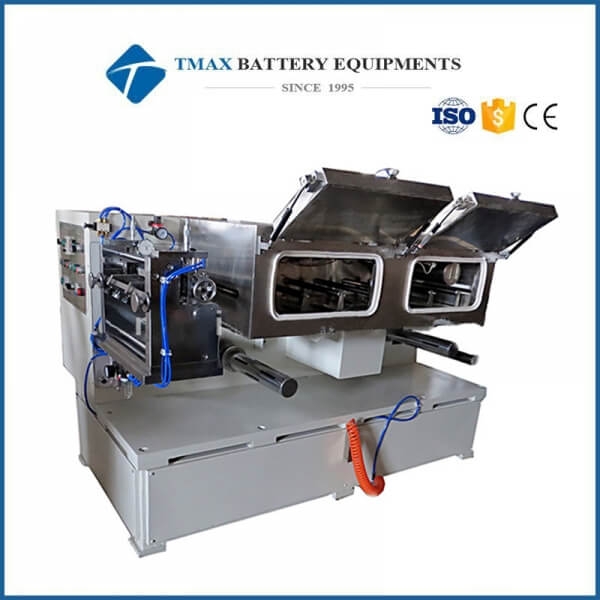- 메일 주소 : David@tmaxcn.com
- 메일 주소 : Davidtmaxcn@gmail.com
- : No. 39, Xinchang Road, Xinyang, Haicang Dist., Xiamen, Fujian, China (Mainland)
블로그
Dry Electrode Scale Line
August 8,2025.
Xiamen Tmax Battery Equipments Limited was set up as a manufacturer in 1995, dealing with lithium battery equipments, technology, etc. We have total manufacturing facilities of around 200000 square foot and more than 230 staff. Owning a group of experie-nced engineers and staffs, we can bring you not only reliable products and technology, but also excellent services and real value you will expect and enjoy.
A dry electrode scale line is a fully automated, highthroughput production system designed to manufacture dry electrodes at an industrial scale. It builds upon the principles and processes validated in dry electrode pilot lines but is optimized for mass production. This scale line eliminates the use of solvents, reduces environmental impact, and enhances the mechanical properties and performance of electrodes for energy storage devices such as lithiumion batteries, solidstate batteries, and supercapacitors.
In this article, we will explore the structure, functionality, advantages, challenges, and innovations associated with dry electrode scale lines.
●What Is a Dry Electrode Scale Line?
A dry electrode scale line is a largescale manufacturing facility that integrates advanced machinery, automation, and process controls to produce dry electrodes in high volumes. It combines the efficiency of dry electrode technology with the scalability required for industrial applications. The scale line ensures consistent quality, high throughput, and costeffective production of electrodes for energy storage devices.
Unlike traditional wetcoating methods, which rely on solventbased slurries, a dry electrode scale line uses dry mixing, compression, and lamination techniques to create electrodes without solvents. This approach significantly reduces waste, energy consumption, and environmental impact while improving the performance and durability of the electrodes.
●Key Components of a Dry Electrode Scale Line
A typical dry electrode scale line consists of the following key components:
1. Dry Mixing System
Blends active materials (e.g., graphite, silicon), binders (e.g., PTFE), and conductive additives (e.g., carbon black) into a homogeneous powder mixture.
Uses highcapacity mixers capable of handling large batches efficiently.
2. Rolling Press Machine
Compresses the dry powder mixture onto a current collector foil (e.g., aluminum or copper) using rollers.
Operates at high speeds while maintaining precise control over pressure and temperature.
3. Laminating Machine
Bonds the compressed electrode film to the current collector foil using heat and pressure.
Ensures strong adhesion and uniform thickness across large areas.
4. Continuous Feeding System
Supplies the dry powder mixture and current collector foil to the rolling press and laminating machines in a continuous and controlled manner.
Maintains proper alignment and tension of the foil during processing.
5. RealTime Monitoring and Control Systems
Measures critical parameters such as thickness, density, and uniformity in realtime.
Provides feedback to adjust process parameters dynamically for optimal results.
6. Quality Inspection System
Detects defects such as air pockets, delamination, or cracks using advanced sensors and vision systems.
Flags defective products for rework or disposal.
7. Waste Collection and Recycling System
Captures excess powder that does not adhere to the foil during processing.
Implements recycling mechanisms to minimize material waste.
8. Automation and Robotics
Integrates collaborative robots (cobots) and IoTenabled systems to enhance efficiency and reduce human intervention.
Enables seamless coordination between different stages of the production process.
●Processes Performed by a Dry Electrode Scale Line
The dry electrode scale line performs the following key processes:
1. Material Preparation: Active materials, binders, and conductive additives are blended into a homogeneous powder mixture.
2. Compression: The powder mixture is compressed onto a current collector foil using rolling presses.
3. Lamination: The compressed electrode film is bonded to the foil using heat and pressure.
4. Monitoring: Realtime measurements ensure the electrode layer meets specifications for thickness, density, and uniformity.
5. Collection: The finished electrodes are collected for further processing, such as cutting and tab welding.
●Advantages of a Dry Electrode Scale Line
1. High Throughput:
Designed for mass production, enabling manufacturers to meet growing demand for energy storage solutions.
2. Cost Savings:
Eliminates solventrelated steps, reducing material costs and energy consumption.
Minimizes waste through precise handling and recycling mechanisms.
3. Environmental Benefits:
Reduces emissions and waste by avoiding the use of toxic solvents.
Aligns with global sustainability goals and regulatory requirements.
4. Improved Performance:
Produces electrodes with higher density, better mechanical stability, and improved cycle life.
Allows for higher loading of active materials, increasing energy density.
5. Scalability:
Easily adaptable to handle different materials and chemistries, including nextgeneration technologies like solidstate batteries.
6. Automation and Efficiency:
Leverages advanced automation and robotics to optimize production speeds and reduce labor costs.
●Challenges of a Dry Electrode Scale Line
Despite its advantages, a dry electrode scale line faces certain challenges:
1. Uniformity Control:
Achieving consistent bonding strength and thickness across large areas can be challenging due to variations in material properties or equipment wear.
2. Material Handling:
Proper feeding and alignment of the dry powder mixture and current collector foil require precise control to avoid defects.
3. Binder Selection:
Developing binders that work effectively in dry conditions while maintaining adhesion and flexibility is complex.
4. High Initial Costs:
Advanced machinery and specialized components come with significant upfront investment.
5. Process Optimization:
Finetuning parameters such as temperature, pressure, and speed is essential for achieving consistent results at scale.
●Innovations in Dry Electrode Scale Lines
To address these challenges and enhance productivity, manufacturers are incorporating cuttingedge technologies:
1. Advanced Roller Designs:
Precisionengineered rollers with optimized surface textures improve bonding and adhesion.
2. AI and Machine Learning:
Predictive analytics optimize machine performance, detect anomalies, and improve yield rates.
3. RealTime Monitoring Systems:
Integrated sensors and vision systems provide continuous feedback on bonding quality, thickness, and uniformity.
4. Modular Design:
Flexible systems allow for easy reconfiguration to test new materials and chemistries.
5. Sustainability Features:
Ecofriendly practices and recycling capabilities minimize waste and energy consumption.
6. Integration with Automation:
Collaborative robotics and IoTenabled systems enhance efficiency and reduce human intervention.
●Applications of Dry Electrode Scale Lines
Dry electrode scale lines are used in various industries, including:
1. Battery Manufacturing:
Produces electrodes for lithiumion batteries, solidstate batteries, and other advanced battery chemistries.
2. Automotive Industry:
Manufactures electrodes for electric vehicle (EV) batteries, focusing on improving energy density and reducing costs.
3. Renewable Energy:
Develops durable electrodes for gridscale energy storage systems.
4. Consumer Electronics:
Produces compact and efficient electrodes for smartphones, wearables, and portable devices.
5. Industrial Applications:
Creates highperformance electrodes for heavyduty applications such as trucks, buses, and construction equipment.
●The Future of Dry Electrode Scale Lines
As the demand for sustainable and highperformance energy storage solutions grows, dry electrode scale lines will continue to evolve. Key trends shaping the future include:
1. Increased Automation:
Fully autonomous systems will further boost production speeds and reduce costs.
2. Customization Options:
Modular designs will enable manufacturers to tailor systems for specific materials and cell designs.
3. Focus on Sustainability:
Ecofriendly practices and recycling capabilities will become integral parts of future systems.
4. Integration with Emerging Technologies:
Solidstate batteries, flexible electronics, and autonomous systems will drive new innovations in system design.
5. Smart Manufacturing:
IoTenabled systems will leverage big data and AI to optimize production, reduce waste, and enhance efficiency.
●Conclusion
Dry electrode scale lines represent the pinnacle of modern energy storage manufacturing, enabling sustainable, efficient, and highperformance electrode fabrication at an industrial scale. Their ability to eliminate solvents, reduce waste, and improve mechanical properties makes them a gamechanger for the battery and supercapacitor industries.
Dry Electrode Scale Line: Enabling Mass Production of Advanced Energy Storage Solutions
A dry electrode scale line is a fully automated, highthroughput production system designed to manufacture dry electrodes at an industrial scale. It builds upon the principles and processes validated in dry electrode pilot lines but is optimized for mass production. This scale line eliminates the use of solvents, reduces environmental impact, and enhances the mechanical properties and performance of electrodes for energy storage devices such as lithiumion batteries, solidstate batteries, and supercapacitors.
In this article, we will explore the structure, functionality, advantages, challenges, and innovations associated with dry electrode scale lines.
●What Is a Dry Electrode Scale Line?
A dry electrode scale line is a largescale manufacturing facility that integrates advanced machinery, automation, and process controls to produce dry electrodes in high volumes. It combines the efficiency of dry electrode technology with the scalability required for industrial applications. The scale line ensures consistent quality, high throughput, and costeffective production of electrodes for energy storage devices.
Unlike traditional wetcoating methods, which rely on solventbased slurries, a dry electrode scale line uses dry mixing, compression, and lamination techniques to create electrodes without solvents. This approach significantly reduces waste, energy consumption, and environmental impact while improving the performance and durability of the electrodes.
●Key Components of a Dry Electrode Scale Line
A typical dry electrode scale line consists of the following key components:
1. Dry Mixing System
Blends active materials (e.g., graphite, silicon), binders (e.g., PTFE), and conductive additives (e.g., carbon black) into a homogeneous powder mixture.
Uses highcapacity mixers capable of handling large batches efficiently.
2. Rolling Press Machine
Compresses the dry powder mixture onto a current collector foil (e.g., aluminum or copper) using rollers.
Operates at high speeds while maintaining precise control over pressure and temperature.
3. Laminating Machine
Bonds the compressed electrode film to the current collector foil using heat and pressure.
Ensures strong adhesion and uniform thickness across large areas.
4. Continuous Feeding System
Supplies the dry powder mixture and current collector foil to the rolling press and laminating machines in a continuous and controlled manner.
Maintains proper alignment and tension of the foil during processing.
5. RealTime Monitoring and Control Systems
Measures critical parameters such as thickness, density, and uniformity in realtime.
Provides feedback to adjust process parameters dynamically for optimal results.
6. Quality Inspection System
Detects defects such as air pockets, delamination, or cracks using advanced sensors and vision systems.
Flags defective products for rework or disposal.
7. Waste Collection and Recycling System
Captures excess powder that does not adhere to the foil during processing.
Implements recycling mechanisms to minimize material waste.
8. Automation and Robotics
Integrates collaborative robots (cobots) and IoTenabled systems to enhance efficiency and reduce human intervention.
Enables seamless coordination between different stages of the production process.
●Processes Performed by a Dry Electrode Scale Line
The dry electrode scale line performs the following key processes:
1. Material Preparation: Active materials, binders, and conductive additives are blended into a homogeneous powder mixture.
2. Compression: The powder mixture is compressed onto a current collector foil using rolling presses.
3. Lamination: The compressed electrode film is bonded to the foil using heat and pressure.
4. Monitoring: Realtime measurements ensure the electrode layer meets specifications for thickness, density, and uniformity.
5. Collection: The finished electrodes are collected for further processing, such as cutting and tab welding.
●Advantages of a Dry Electrode Scale Line
1. High Throughput:
Designed for mass production, enabling manufacturers to meet growing demand for energy storage solutions.
2. Cost Savings:
Eliminates solventrelated steps, reducing material costs and energy consumption.
Minimizes waste through precise handling and recycling mechanisms.
3. Environmental Benefits:
Reduces emissions and waste by avoiding the use of toxic solvents.
Aligns with global sustainability goals and regulatory requirements.
4. Improved Performance:
Produces electrodes with higher density, better mechanical stability, and improved cycle life.
Allows for higher loading of active materials, increasing energy density.
5. Scalability:
Easily adaptable to handle different materials and chemistries, including nextgeneration technologies like solidstate batteries.
6. Automation and Efficiency:
Leverages advanced automation and robotics to optimize production speeds and reduce labor costs.
●Challenges of a Dry Electrode Scale Line
Despite its advantages, a dry electrode scale line faces certain challenges:
1. Uniformity Control:
Achieving consistent bonding strength and thickness across large areas can be challenging due to variations in material properties or equipment wear.
2. Material Handling:
Proper feeding and alignment of the dry powder mixture and current collector foil require precise control to avoid defects.
3. Binder Selection:
Developing binders that work effectively in dry conditions while maintaining adhesion and flexibility is complex.
4. High Initial Costs:
Advanced machinery and specialized components come with significant upfront investment.
5. Process Optimization:
Finetuning parameters such as temperature, pressure, and speed is essential for achieving consistent results at scale.
●Innovations in Dry Electrode Scale Lines
To address these challenges and enhance productivity, manufacturers are incorporating cuttingedge technologies:
1. Advanced Roller Designs:
Precisionengineered rollers with optimized surface textures improve bonding and adhesion.
2. AI and Machine Learning:
Predictive analytics optimize machine performance, detect anomalies, and improve yield rates.
3. RealTime Monitoring Systems:
Integrated sensors and vision systems provide continuous feedback on bonding quality, thickness, and uniformity.
4. Modular Design:
Flexible systems allow for easy reconfiguration to test new materials and chemistries.
5. Sustainability Features:
Ecofriendly practices and recycling capabilities minimize waste and energy consumption.
6. Integration with Automation:
Collaborative robotics and IoTenabled systems enhance efficiency and reduce human intervention.
●Applications of Dry Electrode Scale Lines
Dry electrode scale lines are used in various industries, including:
1. Battery Manufacturing:
Produces electrodes for lithiumion batteries, solidstate batteries, and other advanced battery chemistries.
2. Automotive Industry:
Manufactures electrodes for electric vehicle (EV) batteries, focusing on improving energy density and reducing costs.
3. Renewable Energy:
Develops durable electrodes for gridscale energy storage systems.
4. Consumer Electronics:
Produces compact and efficient electrodes for smartphones, wearables, and portable devices.
5. Industrial Applications:
Creates highperformance electrodes for heavyduty applications such as trucks, buses, and construction equipment.
●The Future of Dry Electrode Scale Lines
As the demand for sustainable and highperformance energy storage solutions grows, dry electrode scale lines will continue to evolve. Key trends shaping the future include:
1. Increased Automation:
Fully autonomous systems will further boost production speeds and reduce costs.
2. Customization Options:
Modular designs will enable manufacturers to tailor systems for specific materials and cell designs.
3. Focus on Sustainability:
Ecofriendly practices and recycling capabilities will become integral parts of future systems.
4. Integration with Emerging Technologies:
Solidstate batteries, flexible electronics, and autonomous systems will drive new innovations in system design.
5. Smart Manufacturing:
IoTenabled systems will leverage big data and AI to optimize production, reduce waste, and enhance efficiency.
●Conclusion
Dry electrode scale lines represent the pinnacle of modern energy storage manufacturing, enabling sustainable, efficient, and highperformance electrode fabrication at an industrial scale. Their ability to eliminate solvents, reduce waste, and improve mechanical properties makes them a gamechanger for the battery and supercapacitor industries.
What excites you most about the role of dry electrode scale lines in driving innovation and sustainability in the energy storage sector? Share your thoughts below! Together, let’s explore how this technology can shape the future of energy storage.
 ru
ru English
English











 +86 13174506016
+86 13174506016 David@tmaxcn.com
David@tmaxcn.com +86 18659217588
+86 18659217588
